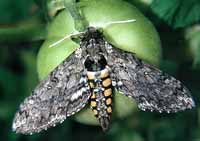Sphinginae subfamily
Sphingini tribe:
 |
Agrius cingulata,
WO Pink-spotted hawkmoth,
fall stray:
Strong migrant and adults nectar from
deep-throated flowers including moonflower (Calonyction aculeatum),
morning glory (Convolvulus), honey suckle (Lonicera)
and petunia (Petunia species). unlikely
|
 |
Ceratomia amyntor
WO,
Elm Sphinx; Four-horned Sphinx:
The upperside of the forewing is brown with dark brown and white
markings including a white costal area near the wing base, dark
streaks along the veins, and a white spot in the cell.
Larvae feed on Elm (Ulmus), birch (Betula), basswood (Tilia), and cherry (Prunus). |
 |
Ceratomia undulosa
WO, Waved Sphinx:
It is named for the wavy lines on the forewings.
Note black and white collar separating thorax from abdomen. |
 |
Reported from northern Minnesota and central western Wisconsin,
it might be present in Wright County. This is one we have on P.E.I.
|
 |
Manduca quinquemaculatus
WO Five-spotted Hawkmoth:
Abdomen usually has five but sometimes six pairs of yellow bands. Forewing upperside
is blurry brown and gray. If you
grow tomatoes, you have probably encountered it.
|
 |
If you grow tomatoes, you have probably encountered Manduca sexta
in the larval stage.
Larvae get very large and can strip a tomato plant.
generally a more southerly species
|
 |
Sphinx chersis
WO, Northern Ash Sphinx;Great Ash
Sphinx: Forewing upperside is soft dark gray to
blue-gray with a series of black dashes, one of which reaches the
wing tip.
Larval hosts are ash, lilac, privet, cherry, and quaking aspen.
|
 |
Forewings, long and slender,
are held close to the body when the moth is at rest.
We have
them on P.E.I., but I do not see them frequently. |
 |
The lower forewings are predominantly brownish-yellow with a fairly
wide dark bar along the inner margin. At rest the wings hug the body,
giving the moth a long slender look.
|
Smerinthini Tribe:
 |
This moth is also fairly widely reported to the east and south
and might be present.
This is the first Sphinx species I reared as a boy in New Jersey.
See the file for the female; she is different. |
 |
Pachysphinx modesta
WO,
the Modest Sphinx or Poplar Sphinx
This moth is also found in Canada. Moths have very heavy bodies.
Larvae eat poplar and willow. |
 |
Named for the dull grey-blue spot in the hindwing, this moth has a
very wide distribution.
I regularly see them on Prince Edward Island. |
 |
Named for the small eye-spot in the hindwing, this moth has a
very wide distribution.
I regularly see them on Prince Edward Island, and they are reported
as far south as Florida.
|
 |
Smerinthus jamaicensis
WO, the Twin-spotted Sphinx:
Smerinthus jamaicensis closely resembles Smerinthus cerisyi,
but jamaicensis is much smaller with larger blue patches on more
vibrant and deeper purple in the lower wings.
|
Macroglossinae subfamily
Dilophonotini tribe:
 |
Erinnyis ello, the Ello Sphinx,
WO:
The abdomen has very distinct gray and black bands.
Adults nectar at dusk so you may see them in the garen at that time.
possibly only as a very rare fall stray
|
 |
Hemaris thysbe
PY, the Hummingbird Clearwing:
This interesting day flier is now confirmed for Wright County.
They are widely distributed in the east from P.E.I. to Florida. |
See Hemaris comparisons.
 |
Hemaris diffinis
WO, the Snowberry Clearwing or Bumblebee Moth:
This moth is widely distributed and
might be present in Wright County.
|
See Hemaris comparison
Philampelini tribe:
 |
Larvae get large and feed on grape vines and Virginia creeper.
|
Macroglossini tribe:
 |
Amphion floridensis
WO/MT,
the Nessus Sphinix:
This day flier is widely distributed. If you have Virginia Creeper, you
might have the Nessus Sphinx. Two bright, distinct, narrow yellow
bands are often visible on the abdomen. generally more southerly
|
Amphion floridensis, Elk River, May 28, 2014, Mike Tillotson
 |
Darapsa myron
WO, the Virginia Creeper Sphinx or the
Grapevine Sphinx:
If you have the foodplants indicated in the common names, you
probably have this species nearby. The lower wings are orange.
|
|
 |
Deidamia inscriptum
WO,
the Lettered Sphinx:
The moth's outer margin of the forewing is deeply scalloped.
The upperside is light brown with dark brown markings.
There is a small black and white spot near the tip.
Grape (Vitis), ampelopsis (Ampelopsis), and Virginia creeper
(Parthenocissus) all serve as larval hosts.
|
 |
Hyles euphorbiae
WO, the Spurge Hawk Moth
The body is light brown with various white and dark brown
markings, while the wings have a conspicuous tan, brown, and pink or
red color pattern.
|
 |
Hyles gallii PY, the Bedstraw Hawk Moth
or Gallium Sphinx:
This species is now reported in Minnesota by Paul Young.
Some years I see them on P.E.I., some years, I do not.
|
 |
Hyles lineata
WO/BL, the White-lined Sphinx:
This species has now been recorded in Wright County, courtesy of
Bonnie Lundgren.
It is a strong migrator from the south,
and there are records from the east and from the west. |
|




